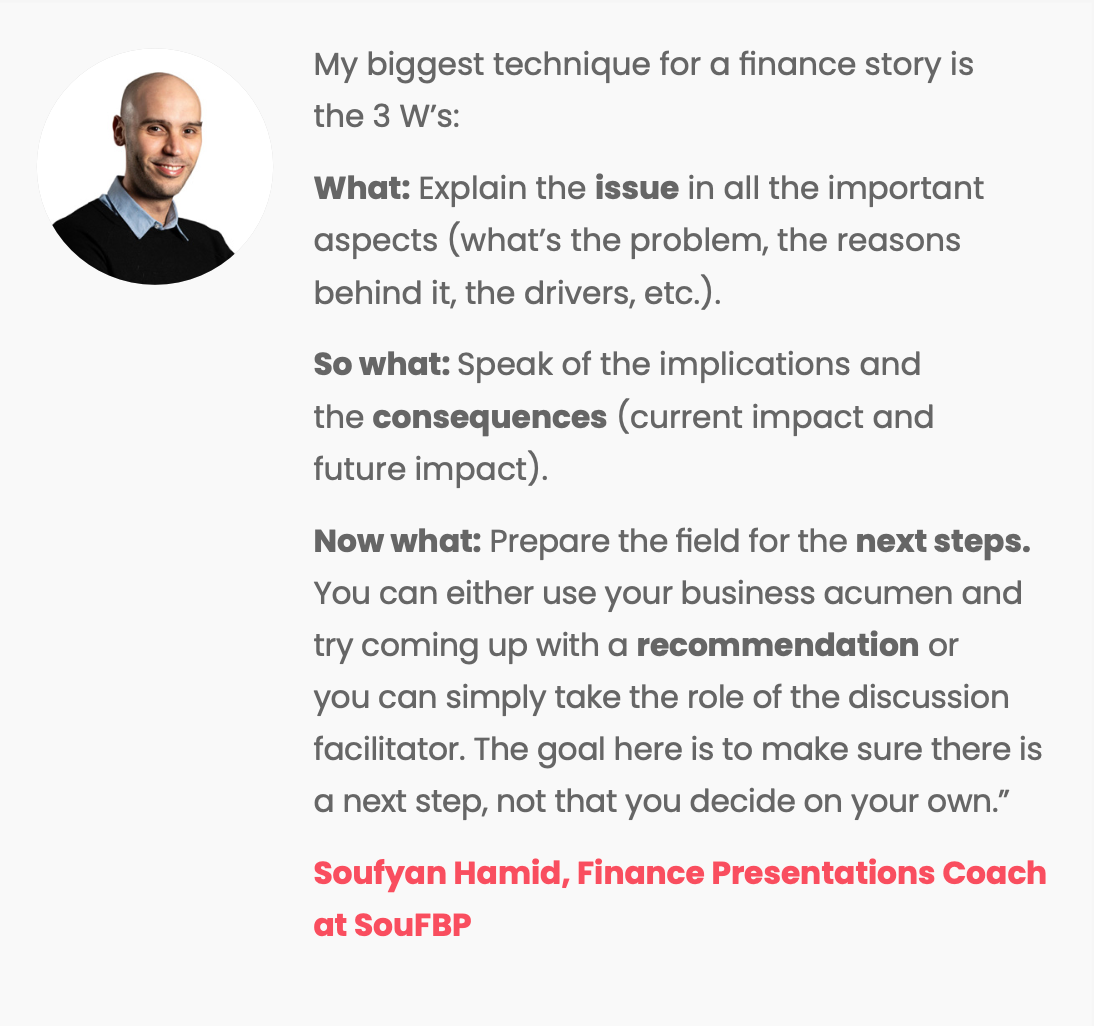7 steps to craft an engaging narrative with financial data
Data visualization storytelling is not just about presenting financial data – it’s about crafting a compelling narrative that resonates with your audience.
Here are seven steps to help do just that:
Step 1 – Identify your audience
Tailor your story to the needs and preferences of your stakeholders, whether they are senior executives, peers, or non-finance professionals. Understand who you’re presenting to and what information is important to them. This will help you tailor your story to their needs and make your data more relevant and engaging.
Step 2 – Define your goal
What do you want to achieve with your story? Whether it’s driving a decision, showcasing a trend, or highlighting a risk, your goal should guide your narrative.
Step 3 – Identify the key message
Identify the main point of your story and use it to guide your narrative. This should be a clear and concise statement that summarizes the key insights from your financial data.
Step 4 – Choose your data wisely
Select the most relevant data to support your story. Avoid overwhelming your audience with too much information or unrelated data points. This means selecting relevant, accurate, and easy-to-understand data.
Use financial data visualization techniques such as charts, graphs, and dashboards to help make your data more visually appealing and easier to interpret.
Step 5 – Craft a compelling storyline
Craft a storyline that engages your audience and leads them on a journey. Use a narrative structure that includes a beginning, middle, and end, and use storytelling techniques such as analogies, metaphors, and examples to make your story more relatable and compelling.
Step 6 – Use real-world examples
Use real-world examples and case studies to show how your financial data has real-world implications and how it can be used to drive better business outcomes. Use these examples to illustrate key points!
Step 7 – Practice and refine
Practice your storytelling skills and refine your narrative over time. Solicit feedback from colleagues and other stakeholders to help improve your storytelling and make your narrative even more compelling.

How to structure your data visualization story for maximum impact
Structuring your data visualization story properly is crucial to ensure your audience understands your key message and takes the desired action. A well-structured story can help you connect with your audience, convey complex information, and inspire action.
To structure your data story effectively, start with a clear and concise message summarizing the main point of your story. This should be the guiding principle informing the rest of your story and helping you to stay focused on your key message.
Once you have your key message locked in, it’s time to think about the overall structure of your story. This means deciding on the order you’ll present the information and the types of data visualization techniques you’ll use to illustrate your points.
One effective way to structure your data visualization story is to use a narrative arc that includes a beginning, middle, and end:
1. The beginning sets the scene and introduces the key players and context.
2. The middle presents key information and data that supports your message.
3. The end summarizes the main points and calls to action.
To structure a powerful data visualization story, follow these five steps:
1. Setting the stage
2. Presenting the problem
3. Showcasing the data
4. Highlighting key insights
5. Offering a conclusion or recommendation

Bonus tips on using financial data to create a compelling story/narrative
1. Use relatable examples
Connect your data to real-world situations or familiar concepts to help your audience understand its significance.
2. Focus on the human element
Whenever possible, emphasize how your data impacts people – whether it’s customers, employees, or stakeholders.
3. Create an emotional connection
Engage your audience’s emotions by highlighting the potential consequences or benefits of the insights derived from your data.
How to build a persuasive argument
When presenting a data story to an audience, such as the CEO and other stakeholders, it’s essential to be prepared for some backlash. This is because financial data can be complex and difficult to understand, and stakeholders may have various interpretations of the data or different priorities and goals.
Resist the urge to jump on the defense. Instead, learn to build a persuasive argument with your financial data storytelling. This means presenting data clearly and concisely and fine-tuning the story so it’s relevant to the audience’s needs and interests. It also means being able to anticipate potential objections or questions and having a plan to address them.
Building a persuasive argument with data storytelling requires a combination of technical expertise and communication skills.
Telling a story that connects with your audience on an emotional level requires the ability to use storytelling techniques such as analogies, metaphors, and examples to make the data more relatable and engaging.
Ultimately, building a persuasive argument with data storytelling is about translating complex financial information into a clear and compelling story that drives better business outcomes.
By anticipating potential objections and building a strong narrative that resonates with your audience, you can build trust, credibility, and influence, even in the face of potential backlash.

4 tips to create a persuasive argument with financial data
1. Use data to support your claims
Present concrete evidence that reinforces your argument and establishes your credibility.
2. Address potential counterarguments
Anticipate objections or alternative interpretations of the data and address them in your visualizations.
3. Keep it simple and focused
Avoid presenting too many data points or arguments at once, as this can dilute your message and confuse your audience.
4. Make a clear call to action
Guide your audience toward the desired outcome by offering a clear, actionable recommendation based on data-driven insights.
Presentation skills
Even the most compelling financial data story can fall flat without effective presentation skills.
Here are some tips to help you shine during your presentations:
1. Practice, practice, practice
Rehearse your presentation to build confidence and ensure a smooth delivery.
2. Engage your audience
Involve your audience by asking questions, soliciting feedback, or encouraging discussion. This will help keep them engaged and invested in your story.
3. Use storytelling techniques
Embrace storytelling techniques such as pacing, tone, and suspense to make your presentation more engaging and memorable.
4. Prepare for questions
Anticipate the questions your audience may have and be ready to address them with confidence and clarity.
5. Use visuals effectively
Ensure that your data visualizations are clear and concise and use them to support your narrative. Avoid cluttering your slides with too much text or unnecessary visuals.
6. Be mindful of body language
Maintain eye contact, stand tall, and use gestures to emphasize key points. Your body language can convey confidence and enthusiasm, which will help to create a strong connection with your audience.
Storytelling with Data Visualization Playbook
Are you tired of presenting financial data that falls flat? Frustrated that your insights are lost in a sea of numbers and charts? Worry no more!
We've created the ultimate playbook to help you transform your financial data into captivating, persuasive stories.
Discover the essential components of a powerful data narrative and learn how to weave them together to create a story that resonates with your audience.



 Follow us on LinkedIn
Follow us on LinkedIn




